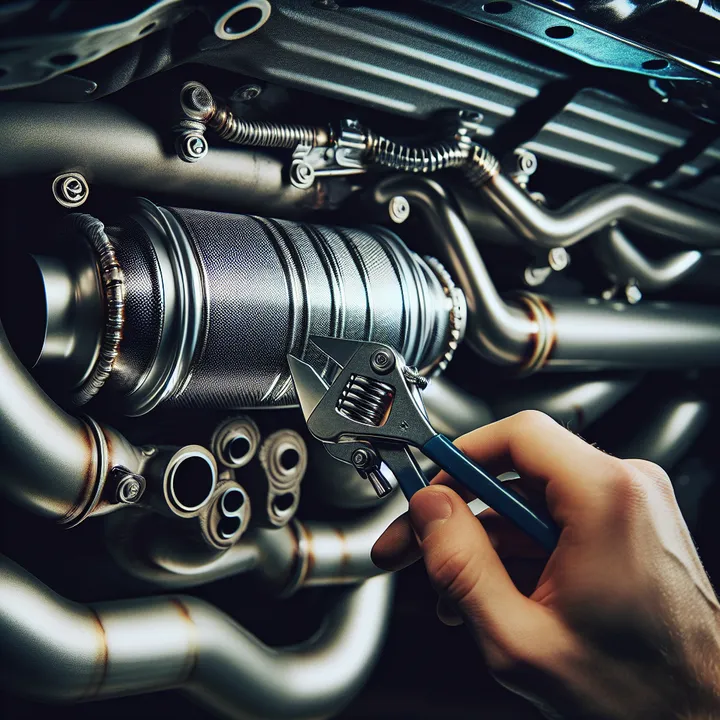


For many automotive enthusiasts, the sound of a performance exhaust system is just as important as the power gains. One popular exhaust modification that can significantly change the exhaust note is the resonator delete. But what exactly is it, and what are the pros and cons? This comprehensive guide will cover everything you need to know about resonator deletes.

A resonator is a component installed in a vehicle's exhaust system, typically located between the catalytic converter and the muffler. Its primary function is to reduce noise and cancel out specific frequencies that contribute to unpleasant sounds or drone.
Resonators work by reflecting and canceling out sound waves of certain frequencies through intricate piping and chambers within the component. This helps create a more pleasant and toned-down exhaust note from the vehicle.
A resonator delete is the process of removing the resonator component from the exhaust system. By eliminating the resonator, you are allowing exhaust gases to flow more freely and altering the way sound waves travel through the exhaust.
Without the resonator's sound-canceling effect, the exhaust note becomes louder, more aggressive, and gains a unique tone or pitch that many enthusiasts find desirable. This is the primary reason why people opt for a resonator delete – to achieve a more aggressive and sporty exhaust sound.
The most obvious benefit of a resonator delete is the change in exhaust sound characteristics. With the resonator removed, the exhaust note becomes louder, raspier, and has more of a high-pitched tone or rasp. This is often described as a more aggressive, sporty, or race-like sound.
Here are some key benefits of a resonator delete:
| Benefit | Description |
|---|---|
| Increased Exhaust Sound/Tone | The exhaust note becomes louder, raspier, and has a more aggressive, high-pitched tone or rasp. |
| Potential Power and Torque Gains | Some vehicles may experience minor gains in power (around 5-10 horsepower) and torque due to improved exhaust flow. |
| Weight Reduction | Removing the resonator reduces the overall weight of the vehicle, albeit by a small amount. |
| Improved Exhaust Flow | With the resonator removed, exhaust gases can flow more directly and with less turbulence, potentially improving overall exhaust efficiency. |
| Customizable Exhaust Note | A resonator delete allows you to customize the exhaust note to your personal preference, achieving a wide range of tones from deep and throaty to high-pitched and raspy. |
While a resonator delete can provide some benefits, there are also potential drawbacks to consider:

Increased Cabin Noise/Drone: Without the resonator's noise-canceling abilities, you may experience more exhaust drone or unwanted frequencies entering the cabin, especially at certain RPM ranges. This can become fatiguing on longer drives and potentially compromise cabin comfort.
Possibility of Voiding Warranty: Modifying the exhaust system by removing the resonator can potentially void your vehicle's warranty, as it is an alteration from the original equipment manufacturer (OEM) specifications. It's crucial to check with your manufacturer or dealer to understand the implications.
Check Engine Light Issues: On some vehicles, a resonator delete can cause changes in backpressure that may trigger the check engine light or throw error codes related to the exhaust system. This can lead to additional diagnostic and repair costs if not addressed properly.
Rough Idling on Older Vehicles: Older vehicles with high mileage may experience rough idling after a resonator delete due to the changes in backpressure and the catalytic converter's performance. This can be particularly noticeable in vehicles with worn-out exhaust components or those in need of maintenance.
Decreased Fuel Efficiency: While not a significant decrease, some drivers may notice a slight drop in fuel efficiency after a resonator delete due to the changes in exhaust flow and backpressure. The impact on fuel economy may vary depending on the vehicle and driving conditions.
If you decide to proceed with a resonator delete, it's essential to have it done correctly to avoid any issues. Here's a general overview of the process:
Locate the Resonator: The first step is to locate the resonator, which is typically situated between the catalytic converter and the muffler, underneath the vehicle.
Cut and Remove: Using appropriate tools, the resonator will be cut out from the exhaust piping and removed entirely from the system.
Weld or Install Piping: Depending on the exhaust setup, the remaining pipes may need to be welded together, or a replacement pipe section installed to bridge the gap left by the removed resonator.
Adjust Hangers and Supports: After the modification, it's crucial to ensure that the exhaust system is properly supported and aligned by adjusting the hangers and supports as necessary.
Tools and Equipment Needed: To perform a resonator delete, you'll need specialized tools and equipment, such as exhaust pipe cutters, welding equipment (if welding is required), and appropriate safety gear.
It's highly recommended to have a professional exhaust shop or muffler installer handle the job. They have the proper equipment, expertise, and can ensure a safe and leak-free installation. Expect to pay around $100-300 for professional installation, depending on your location and vehicle.
The legality of a resonator delete can vary depending on your location and local emissions regulations. In many areas, it is generally legal to remove the resonator as it does not directly impact emissions compliance. However, some regions or states have stricter laws regarding exhaust modifications.
| Location | Legality |
|---|---|
| Most Areas | Generally legal, as it does not directly impact emissions compliance. |
| Regions with Strict Emissions Laws | May be illegal or require additional testing/inspections. |
It's crucial to check your local regulations and ensure compliance before proceeding with the modification to avoid potential fines or issues during vehicle inspections.
It's important to distinguish a resonator delete from a muffler delete, as they have different effects on the exhaust sound.
| Modification | Sound Characteristics |
|---|---|
| Muffler Delete | Typically results in an extremely loud and raspy exhaust note, often considered too loud for street use and potentially violating noise ordinances. |
| Resonator Delete | Provides a more moderate increase in volume and tone while still remaining relatively street-friendly in most cases. The sound is usually described as more aggressive and sporty rather than obnoxiously loud. |
While both modifications involve altering the exhaust system, a resonator delete is generally considered a more moderate and street-friendly option compared to a muffler delete, which can produce an excessively loud and potentially illegal exhaust note.
To better understand the sound differences, here are some examples of exhaust notes before and after a resonator delete:
[Insert relevant audio/video examples showcasing different vehicles]
As you can hear, the resonator delete provides a noticeable change in exhaust tone, with more rasp, burbles, and a unique pitch compared to the stock exhaust note.
A resonator delete is a popular exhaust modification that can significantly enhance the sound characteristics of your vehicle's exhaust system. By removing the resonator, you can achieve a more aggressive, sporty, and unique exhaust note that many enthusiasts find desirable.
While a resonator delete offers benefits such as increased exhaust volume, potential power gains, and weight reduction, it's essential to consider the potential drawbacks, including increased cabin noise, warranty implications, and legal concerns. If done correctly and within legal limits, a resonator delete can be an excellent way to customize your exhaust note and achieve the desired aggressive sound.
Remember, it's crucial to have a professional exhaust shop or muffler installer perform the resonator delete to ensure proper installation, avoid exhaust leaks, and maintain the integrity of your vehicle's exhaust system. Additionally, always check your local regulations and emissions requirements to ensure compliance and avoid potential fines or issues.
By understanding the pros, cons, and intricacies of a resonator delete, you can make an informed decision on whether this modification aligns with your preferences and driving needs.
A resonator is designed to reduce noise and cancel out specific frequencies that contribute to unpleasant sounds or drone from the exhaust. It helps create a more pleasant and toned-down exhaust note.
Without the resonator's sound-canceling effect, the exhaust note becomes louder, more aggressive, and gains a unique tone or pitch that many enthusiasts find desirable.
Yes, some vehicles may experience minor gains in power (around 5-10 horsepower) and torque due to improved exhaust flow after a resonator delete.
Modifying the exhaust system by removing the resonator can potentially void your vehicle's warranty, as it is an alteration from the original equipment manufacturer (OEM) specifications.
A resonator delete provides a more moderate increase in volume and tone, while a muffler delete typically results in an extremely loud and raspy exhaust note, often considered too loud for street use.
Expect to pay around $100-300 for professional installation, depending on your location and vehicle.
No, the legality of a resonator delete can vary depending on your location and local emissions regulations. Some regions or states have stricter laws regarding exhaust modifications.
Yes, older vehicles with high mileage may experience rough idling after a resonator delete due to the changes in backpressure and the catalytic converter's performance.
Specialized tools and equipment are required, such as exhaust pipe cutters, welding equipment (if welding is required), and appropriate safety gear.
While not a significant decrease, some drivers may notice a slight drop in fuel efficiency after a resonator delete due to the changes in exhaust flow and backpressure.

Sarah isn't your average gearhead. With a double major in Mechanical Engineering and Automotive Technology, she dived straight into the world of car repair. After 15 years of turning wrenches at dealerships and independent shops, Sarah joined MICDOT to share her expertise and passion for making cars run like new. Her in-depth knowledge and knack for explaining complex issues in simple terms make her a valuable asset to our team.











